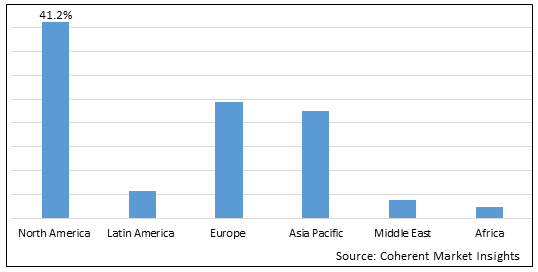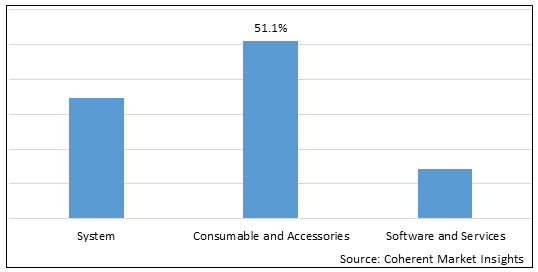Robotic-assisted Surgery Systems Market is estimated to be valued at USD 12,531.3 Mn in 2025 and is expected to reach USD 37,385 Mn in 2032, exhibiting a compound annual growth rate (CAGR) of 16.9% from 2025 to 2032. The global robotic-assisted surgery systems market is experiencing strong growth due to the increase in prevalence of chronic diseases and increase in number of surgical procedures around the world. Moreover, growing preference for minimally invasive surgeries and rise in adoption of surgical robots worldwide is expected to boost the growth of the market. However, factors such as high cost of robotic devices and stringent regulatory processes are expected to hamper growth of the global robotic-assisted surgery systems market.
Global Robotic-assisted Surgery Systems Market: Regional Insights
Based on geography, the global robotic-assisted surgery systems market is segmented into North America, Europe, Asia Pacific, Latin America, and Middle East & Africa.
Among regions, North America is expected to gain highest share in the market during the forecast period due to the rise in the burden of chronic diseases, increasing number of surgeries, increasing adoption of surgical robots, and rise in healthcare expenditure in the region. For instance, in March 2021, Asensus Surgical received clearance from the U.S. Food & Drug Administration (FDA) for its Senhance Surgical System, a digital laparoscopic platform that uses augmented intelligence to provide unmatched performance and patient outcomes through machine learning and provides surgical assurance through haptic feedback, eye-tracking camera control, and 3D visualization.​
Europe and Asia Pacific are also expected to witness robust growth in the global robotic-assisted surgery systems market owing to the increasing prevalence of chronic diseases, rising number of surgical procedures, and rise in adoption of surgical robots in these regions. For instance, robotic-assisted surgery systems, surgical robots, are used in chronic disorders such as minimally invasive cardio procedures with less blood loss and few post-surgery complications. According to European Chronic Disease Alliance (ECDA), chronic diseases are by far the leading cause of mortality in Europe, representing 77% of the total disease burden and 86% of all deaths.
Figure 1. Global Robotic-assisted Surgery Systems Market Share (%), by Region, 2025

To learn more about this report, Download Free Sample
Global Robotic-assisted Surgery Systems Market Drivers:
High prevalence of chronic diseases to boost market growth
One of the key factors expected to augment growth of the global robotic-assisted surgery systems market over the forecast period is the increase in prevalence of chronic diseases worldwide. Such a high burden of chronic diseases leads to an increased number of surgical procedures, driving the market growth. According to the World Health Organization (WHO), noncommunicable diseases (NCDs) kill 41 million people each year, equivalent to 74% of all deaths globally. Cardiovascular diseases account for most NCD deaths, or 17.9 million people annually, followed by cancers (9.3 million), chronic respiratory diseases (4.1 million), and diabetes (2.0 million).
Rising number of surgical procedures to propel market growth
Another factor which is driving the growth of the global robotic-assisted surgery systems market is the rising number of surgical procedures around the world. For instance, with the rise in burden of chronic diseases, the number of surgical procedures is also increasing, as chronic diseases leads to an increased number of surgical procedures. According to the National Institute of Health (NIH), globally, a staggering 310 million major surgeries are performed each year; around 40 to 50 million in the United States and around 20 million in Europe. This in turn is expected to increase adoption of robotic-assisted surgery systems across the world.
Global Robotic-assisted Surgery Systems Market Opportunities:
Growing preference for minimally invasive surgeries worldwide is expected to provide significant growth opportunities for players in the robotic-assisted surgery systems market. For instance, the preference for robotic-assisted surgical systems is increasing due to associated advantages, such as facilitation of precise, tremor-free surgery and benefits of minimally invasive methods. In June 2020, Titan Medical announced the development and license agreements with Medtronic for the development of robotic-assisted surgical technologies for use by both Titan and Medtronic in their respective businesses. This in turn is driving the market growth.
Rise in adoption of surgical robots worldwide is expected to offer lucrative growth opportunities for players in the global robotic-assisted surgery systems market. For instance, many hospitals and other institutions across the globe are actively adopting robotic-assisted surgical systems (surgical robots) to enhance their surgical procedures in terms of patient outcomes. For instance, in 2020, Apollo Hospital Networks planned to install about 80 robotic-assisted surgery setups across India to perform general, oncology, urology, and bariatric surgeries. Moreover, they launched Robotic Joint Replacement Program to perform knee replacement surgeries.
Robotic-assisted Surgery Systems Market Report Coverage
| Report Coverage | Details | ||
|---|---|---|---|
| Base Year: | 2024 | Market Size in 2025: | USD 12,531.3 Mn |
| Historical Data for: | 2020 To 2024 | Forecast Period: | 2025 To 2032 |
| Forecast Period 2025 to 2032 CAGR: | 16.9% | 2032 Value Projection: | USD 37,385 Mn |
| Geographies covered: |
|
||
| Segments covered: |
|
||
| Companies covered: |
Zimmer Biomet Holdings Inc., Globus Medical, Avatera Medical GmbH, NuVasive Inc., Brainlab, Smith & Nephew PLC, Medtronic PLC, Renishaw PLC, Think Surgical Inc., Accuray Incorporated, SRI International, Stryker Corporation, Intuitive Surgical Inc., and Johnson & Johnson Inc. (Verb Surgical Inc. and Auris Health Inc.), among others. |
||
| Growth Drivers: |
|
||
| Restraints & Challenges: |
|
||
Uncover macros and micros vetted on 75+ parameters: Get instant access to report
Global Robotic-assisted Surgery Systems Market Trends:
Introduction of insurance schemes is a recent trend
The introduction of insurance schemes by governments, such as Ayushman Bharat by the Indian Government, is expected to increase the usage of robotic surgical systems. The scheme is expected to cover about ten crore families below the poverty line. With such schemes in place, more patients will be able to afford robotic-assisted surgery, increasing the adoption of robotic-assisted surgical systems (surgical robots) worldwide. This trend is expected to continue over the forecast period, driving the robotic-assisted surgery systems market growth.
Technological advancements is another trend
Technologies such as artificial intelligence, big data, and various other technological advances are becoming commonly accepted ways to deal with and treat a wide variety of conditions and medical applications such as surgery. Moreover, various other initiatives are being taken by the government and other organizations across the globe to create awareness and promote the adoption of robotic-assisted systems (surgical robots). This trend is also expected to continue over the forecast period, driving the growth of the robotic-assisted surgery systems market.
Global Robotic-assisted Surgery Systems Market Restraints:
High cost of robotic devices to hinder market growth
One of the key factors expected to hamper growth of the global robotic-assisted surgery systems market is the high cost of robotic devices. For instance, the cost of robotic systems is a significant barrier for the studied market. Therefore, many healthcare facilities worldwide cannot afford these systems for the benefit of patients due to their high cost. Moreover, the annual maintenance costs and the disposable supply cost of these systems are also high, putting them out of reach for many institutions and healthcare systems.
Stringent rules and regulations to hamper market growth
Another factor which is hampering growth of the global robotic-assisted surgery systems market is the stringent regulatory processes. Robotic-assisted surgery is an important treatment option that is safe/effective when used appropriately & with proper training. Over the years, robotic surgeries have resulted in more deaths, injuries, and malfunctions owing to a lack of regulations as surgeons using robotic-assisted surgery systems require different skills than regular surgeons, such as the ability to control the robot’s manipulators.
Figure 2. Global Robotic-assisted Surgery Systems Market Share (%), by Product Type, 2025

To learn more about this report, Download Free Sample
Global Robotic-assisted Surgery Systems Market Segmentation:
The robotic-assisted surgery systems market report is segmented into Product Type, Application, End User, and Geography.
Based on Product Type, the market is segmented into Surgical Robot and Navigation System. Of which, Surgical Robot Segment is expected to dominate the robotic-assisted surgery systems market over the forecast period and this is attributed to the increasing number of surgical robots across the globe. Surgical robot systems help surgeons during surgical procedures.
Navigation System Segment is also expected to witness significant growth in the near future and this is due to the increase in adoption of navigation system. Surgical navigation technology allows surgeons to precisely track instrument positions and then project the instrument position onto the preoperative imaging data.
Based on Application, the market is segmented into Gynecological Surgery, Cardiovascular, Neurosurgery, Orthopedic Surgery, Laparoscopy, Urology, and Other Applications. Out of which, Gynecological Surgery Segment is expected to dominate the market over the forecast period and this is attributed to the increasing number of gynecological surgeries.
Cardiovascular Segment is also expected to witness significant growth in the near future and this is owing to increasing prevalence of cardiovascular diseases.
Based on End User, the market is segmented into Hospitals, Ambulatory Surgery Centers, and Other End Users. Out of which, Hospitals Segment is expected to dominate the market over the forecast period and this is attributed to the growing preference for minimally invasive surgeries.
Ambulatory Surgery Centers Segment is also expected to witness significant growth in the near future and this is owing to increase in burden of chronic diseases.
Global Robotic-assisted Surgery Systems Market: Key Developments
In January 2022, Smith+Nephew announced the commercial launch of next generation handheld robotics platform, CORI Surgical System, in Japan. It is designed to augment surgical experience for high accuracy and improved outcomes in knee arthroplasty.
In December 2021, Intuitive Surgical Inc. received the U.S. Food and Drug Administration (FDA) clearance for fully wristed, 8 mm SureForm 30 Curved-Tip Stapler and reloads (gray, white, and blue) for general, thoracic, gynecologic, urologic, and pediatric surgery.
In November 2021, CMR Surgical received regulatory approval from Brazilian Health Regulatory Agency (Anvisa) for its Versius Surgical Robotic System.
In October 2021, iotaMotion Inc. received the Food and Drug Administration (FDA) approval for iotaSOFT insertion system, a robotic-assisted insertion technology intended to help surgeons place cochlear implant electrode arrays by controlling the placement of cochlear implant electrode arrays the speed of implant insertion.
Global Robotic-assisted Surgery Systems Market: Key Companies Insights
The global robotic-assisted surgery systems market is highly competitive. This is attributed to the increasing number of surgeries and increasing adoption of surgical robots, as a result, players in the market are focusing on launching novel products in the market.
Some of the key players in the global robotic-assisted surgery systems market are Zimmer Biomet Holdings Inc., Globus Medical, Avatera Medical GmbH, NuVasive Inc., Brainlab, Smith & Nephew PLC, Medtronic PLC, Renishaw PLC, Think Surgical Inc., Accuray Incorporated, SRI International, Stryker Corporation, Intuitive Surgical Inc., and Johnson & Johnson Inc. (Verb Surgical Inc. and Auris Health Inc.), among others.
*Definition: Robotic surgery, or robot-assisted surgery, allows doctors to perform many types of complex procedures with more precision, flexibility, and control than is possible with conventional techniques. Robotics-assisted surgical systems are guided by professional, certified surgeons to facilitate the procedure being conducted.
Share
Share
About Author
Manisha Vibhute is a consultant with over 5 years of experience in market research and consulting. With a strong understanding of market dynamics, Manisha assists clients in developing effective market access strategies. She helps medical device companies navigate pricing, reimbursement, and regulatory pathways to ensure successful product launches.
Missing comfort of reading report in your local language? Find your preferred language :
Transform your Strategy with Exclusive Trending Reports :
Frequently Asked Questions
Select a License Type
Joining thousands of companies around the world committed to making the Excellent Business Solutions.
View All Our Clients